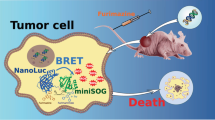Abstract
Photodynamic therapy (PDT) is a clinically approved, minimally invasive method for tumor destruction in the presence of a photosensitizer (PS), oxygen, and a light source. The main obstacle for the PDT treatment of deep tumors is the problem of the excitation light delivery inside the body without reduction of light intensity. An internal light source based on a bioluminescence system NanoLuc-furimazine can be considered as an alternative to an external light source. This system can be successfully used to excite a protein photosensitizer miniSOG and induce its phototoxicity in cancer cells as a result of bioluminescent resonance energy transfer. In this paper, the effectiveness of bioluminescent resonance energy transfer in the NanoLuc-miniSOG-furimazine system in living cells was studied. The efficiency of the energy transfer in this system was found to be independent of the furimazine concentration, while intracellular localization of the NanoLuc-miniSOG hybrid protein was found to be a crucial factor.
Similar content being viewed by others
Abbreviations
- PDT:
-
photodynamic therapy
- PS:
-
photosensitizer
- BRET:
-
bioluminescence resonance energy transfer
- FRET:
-
fluorescence resonance energy transfer
References
Ciruela, F., Curr. Opin. Biotechnol., 2008, vol. 19, pp. 338–343.
Loening, A.M., Wu, A.M., and Gambhir, S.S., Nat. Methods, 2007, vol. 4, pp. 641–643.
De, A., Jasani, A., Arora, R., and Gambhir, S.S., Front. Endocrinol. (Lausanne), 2013, vol. 4, p. 131.
De, A., Loening, A.M., and Gambhir, S.S., Cancer Res., 2007, vol. 67, pp. 7175–7183.
Kim, Y.R., Kim, S., Choi, J.W., Choi, S.Y., Lee, S.H., Kim, H., Hahn, S.K., Koh, G.Y., and Yun, S.H., Theranostics, 2015, vol. 5, pp. 805–817.
Saito, K., Chang, Y.-F., Horikawa, K., Hatsugai, N., Higuchi, Y., Hashida, M., Matsuda, T., Arai, Y., and Nagai, T., Nat. Communs., 2012, vol. 3, p. 1262.
Hall, M.P., Unch, J., Binkowski, B.F., Valley, M.P., Butler, B.L., Wood, M.G., Otto, P., Zimmerman, K., Vidugiris, G., Machleidt, T., Robers, M.B., Benink, H.A., Eggers, C.T., Slater, M.R., Meisenheimer, P.L., Klaubert, D.H., Fan, F., Encell, L.P., and Wood, K.V., ACS Chem. Biol., 2012, vol. 7, pp. 1848–1857.
Kamkaew, A., Sun, H., England, C.G., Cheng, L., Liu, Z., and Cai, W., Chem. Communs. (Camb.), 2016, vol. 52, pp. 6997–7000.
Zdobnova, T.A., Lebedenko, E.N., and Deyev, S.M., Acta Naturae, 2011, vol. 3, pp. 29–47.
Schaub, F.X., Reza, M.S., Flaveny, C.A., Li, W., Musicant, A.M., Hoxha, S., Guo, M., Cleveland, J.L., and Amelio, A.L., Cancer Res., 2015, vol. 75, pp. 5023–5033.
Shramova, E.I., Proshkina, G.M., Deyev, S.M., and Petrov, R.V., Dokl. Biochem. Biophys, 2017, vol. 474, pp. 228–230.
Shramova, E.I., Proshkina, G.M., Chumakov, S.P., Khodarovich, Y.M., and Deyev, S.M., Acta Naturae, 2016, vol. 8, pp. 118–123.
Shu, X., Lev-Ram, V., Deerinck, T.J., Qi, Y., Ramko, E.B., Davidson, M.W., Jin, Y., Ellisman, M.H., and Tsien, R.Y., PLoS Biol., 2011, vol. 9, e1001041.
Eidne, K.A., Kroeger, K.M., and Hanyaloglu, A.C., Trends Endocrinol. Metab., 2002, vol. 13, pp. 415–421.
Pfleger, K.D. and Eidne, K.A., Nat. Methods, 2006, vol. 3, pp. 165–174.
Author information
Authors and Affiliations
Corresponding author
Additional information
Original Russian Text © E.I. Shramova, S.M. Deyev, G.M. Proshkina, 2018, published in Bioorganicheskaya Khimiya, 2018, Vol. 44, No. 6, pp. 664–668.
Rights and permissions
About this article
Cite this article
Shramova, E.I., Deyev, S.M. & Proshkina, G.M. Efficiency of Bioluminescence Resonance Energy Transfer in the NanoLuc-miniSOG-Furimazine System. Russ J Bioorg Chem 44, 755–758 (2018). https://doi.org/10.1134/S1068162018060080
Received:
Accepted:
Published:
Issue Date:
DOI: https://doi.org/10.1134/S1068162018060080




